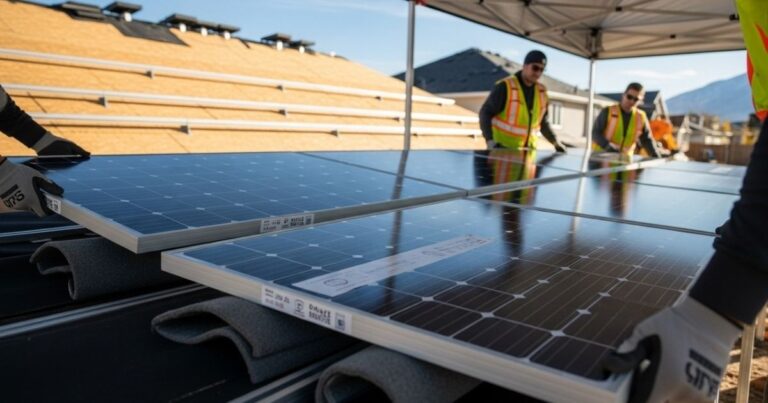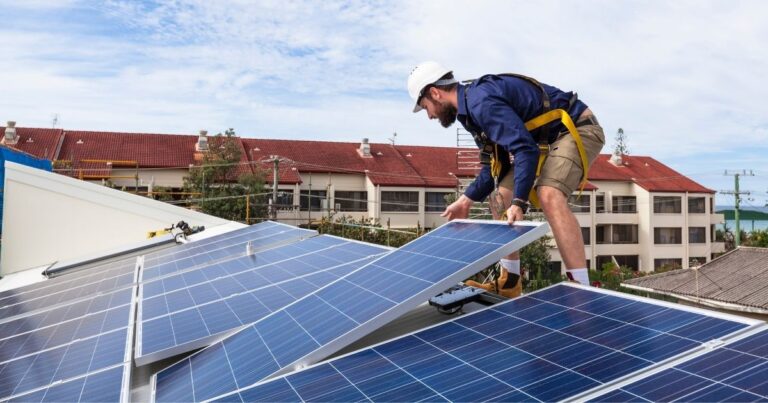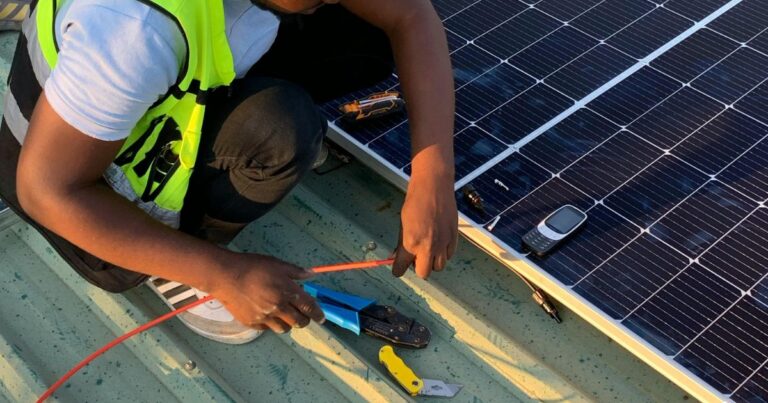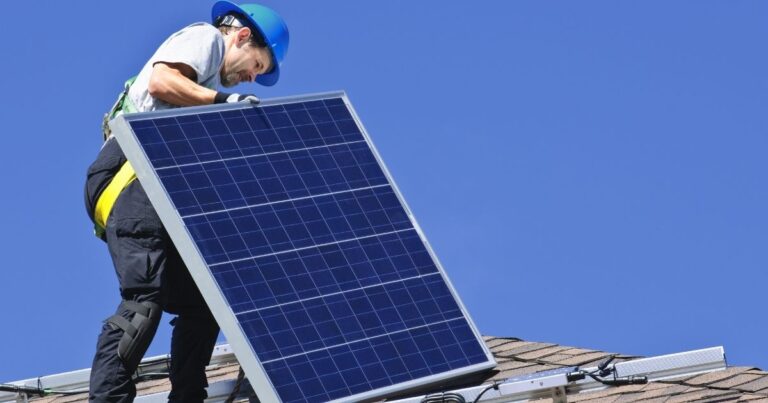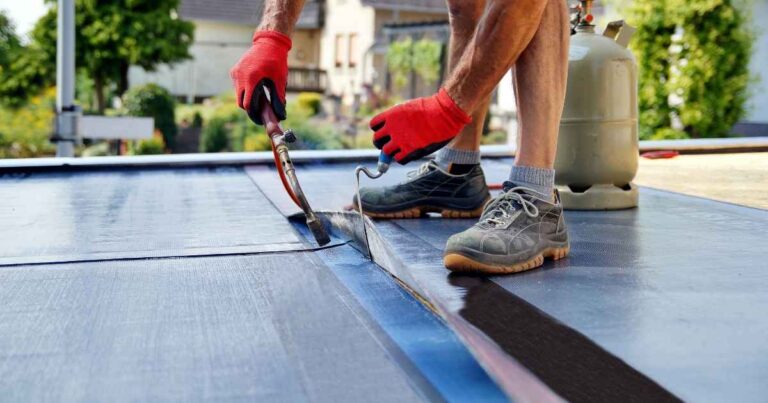What Happens to Solar Panels During Roof Replacement?
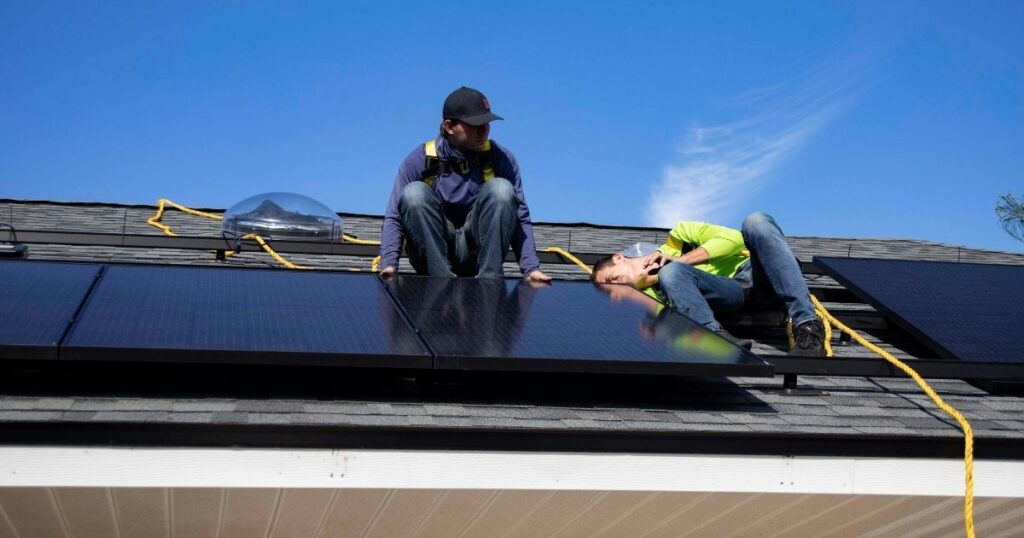
When your roof needs work, it’s natural to ask what happens to solar panels during roof replacement—do they stay put, who handles them, and how do you protect your warranty and insurance claim? This guide gives you a clear, step-by-step look at how panels are safely removed, stored, and reinstalled, what affects cost, and how coordination with roofers and insurers keeps your project on schedule. Read on to understand the process and your best options—without the stress or guesswork.
In this article, we’ll cover:
- Understanding What Happens to Solar Panels During Roof Replacement
- The Solar Detach & Reset Process (Step-by-Step)
- Cost Factors and Insurance Coverage
- Protecting Your Solar Warranty and Investment
- Coordinating Between Homeowners, Roofers, and Insurance Teams
- Why Professional Detach & Reset Services Are Worth It
- Conclusion – A Stress-Free Roof Replacement Is Possible
First, let’s understand what actually happens to your panels when roof work begins.
Understanding What Happens to Solar Panels During Roof Replacement
If you’re planning roof work and wondering do solar panels need to be removed for roof replacement, the short answer is: they’re temporarily removed by specialists, stored safely, and reinstalled after the new roof is in place.
This keeps your system protected, preserves warranties, and gives roofers clear access to do quality work. The process is common, straightforward when coordinated well, and designed to get your home producing power again quickly.
Why your solar panels can’t stay on during roof work
Keeping panels in place during a tear-off or re-shingle isn’t safe for people or equipment. Roofers need clear access to the entire surface to inspect decking, replace underlayment, and properly flash penetrations. Panels, racking, and wiring block that access and are at risk from debris, foot traffic, and tools.
Think of it like painting a room: you can tape around furniture, but moving it out first results in a cleaner, faster job with fewer mistakes. Similarly, removing panels allows roofers to work efficiently while protecting the electrical components and glass surfaces from damage. It also ensures the roofers can correctly waterproof around mounting points—critical to preventing leaks later.
That’s why a defined solar panel removal and reinstallation process exists. It typically includes: confirming system documentation, shutting down power safely, labeling and disconnecting wiring, removing panels and racking, storing components securely (on-site or off-site), then reinstalling and testing once the new roof is complete.
Who removes solar panels before a roof replacement?
Most roofing crews do not handle live solar electrical systems—and they shouldn’t; for that you’ll want certified companies that remove and reinstall solar panels to safely manage the process. Roofers are experts in roofing; solar technicians are trained to safely disconnect, label, and later reinstall your array so it performs exactly as before. That’s where hiring a solar panel removal specialist comes in.
In practice, your roofer schedules the roof work while the solar team coordinates the timing of removal and reinstallation. This roofing contractor coordination with solar companies keeps the project moving: panels come off just before tear-off and go back on shortly after the new roof is ready. For homeowners and insurance adjusters, it also means clear documentation at every step—useful for warranty protection and storm or hail damage claims.
Key takeaway: During a roof replacement, panels are removed, stored, and professionally reinstalled so roofers can do the job right and your solar investment stays protected. With the right coordination, the process is safe, predictable, and warranty-friendly.
The Solar Detach & Reset Process (Step-by-Step)
Replacing a roof when you have solar panels doesn’t have to be complicated—especially if you follow a proven solar panel removal process carried out by professionals. This process, known as a solar panel detach and reset, ensures your panels, roof, and warranty all remain protected from start to finish.
Here’s how a professional solar panel removal and reinstallation process works from beginning to end:
Step 1 – Pre-inspection and documentation
Before any tools come out, a detailed pre-inspection sets the foundation for a smooth project. The solar team assesses the system layout, checks wiring, and takes high-resolution photos of every component and connection. This documentation ensures everything goes back exactly where it belongs.
If your roof work is part of a storm or hail damage claim, this step also supports insurance documentation. Accurate pre- and post-photos, along with equipment details, help insurance adjusters verify that the system was properly handled and restored. It’s the paper trail that protects your claim and your investment.
Step 2 – Safe removal and electrical disconnect
Once the system is mapped and documented, technicians safely shut down and disconnect the electrical components. This involves detaching solar panels safely, de-energizing the system, labeling wires, and carefully unmounting panels and racking.
Professionals follow manufacturer-approved solar removal methods to prevent any damage to panels, wiring, or roof penetrations. Electrical safety is paramount—disconnecting a solar array isn’t as simple as unplugging it. DOE’s Energy Saver explains that safety disconnects isolate PV systems for maintenance and protect people and equipment—one reason qualified technicians manage shutdowns and reconnection.
Step 3 – Panel storage and roofing phase
Once removed, panels are stored using solar panel storage solutions—either on-site in a protected area or off-site in insured storage. This prevents damage from weather or job-site traffic while roofers get to work replacing the roof.
During this stage, communication between the roofing subcontractor and solar technicians is essential. The solar team coordinates with the roofer’s schedule to make sure the panels come off and go back on at the right times. This coordination keeps the project moving efficiently and helps roofers complete the tear-off, underlayment, and installation without delays or liability concerns.
Step 4 – Reinstallation, reconnect, and performance testing
Once the new roof is finished and inspected, the solar team handles professional solar panel reinstallation using new flashing and hardware where needed to ensure watertight seals. Each panel is reconnected, grounded, and tested to verify that the system is operating exactly as it did before.
This final phase—sometimes called the reset—includes full solar array reconnect and performance testing. Professionals confirm that energy production, monitoring, and inverter communication are all functioning properly. For homeowners, it’s the assurance that the solar system is back online safely and efficiently.
Key takeaway: A proper detach and reset isn’t just about removing panels—it’s about doing it the right way. From detailed documentation to safe electrical handling, insured storage, and post-install testing, each step ensures your solar panels and roof are protected from risk. When experienced specialists manage the process, your roof replacement stays on schedule—and your solar system performs like new.
Cost Factors and Insurance Coverage
One of the most common questions homeowners have is about the cost of removing and reinstalling solar panels during a roof replacement—and whether insurance helps cover it. The truth is, pricing can vary depending on several factors, but understanding how these costs are determined (and when they may be covered) can help you plan with confidence and avoid unnecessary surprises.
What affects the cost of solar panel removal and reinstallation
Every solar system is unique, so the cost of a solar panel detach and reset depends on your home’s configuration and the scope of roof work involved. Here are the key factors that influence the price:
- System size and number of panels: Larger systems take more time and labor to safely remove, store, and reinstall.
- Roof type and pitch: Steeper or more complex roofs—especially those with multiple angles or obstructions—require extra care and coordination.
- Mounting hardware and flashing: Some older systems or specialty racking may need new solar panel mounting hardware and roof underlayment to ensure a watertight reinstall.
- Storage and access: Costs can vary depending on whether panels are stored on-site or transported off-site for safety.
- Scheduling and coordination: When multiple contractors are involved (roofer, solar tech, insurance adjuster), a seamless timeline saves both time and cost.
Ultimately, the cost isn’t just about labor—it’s about protecting your investment. Hiring a professional service ensures the removal and reinstall process is warranty-safe and fully documented, avoiding much higher costs from damage, leaks, or voided warranties later on.
Average cost range for solar detach and reset
In Northern Utah, the average cost to remove and reinstall solar panels for roof replacement typically ranges between $1,500 and $3,500 for smaller systems, and $3,500 to $6,000 or more for larger arrays. The final amount depends on panel count, accessibility, roof type, and whether new hardware or wiring updates are needed.
While that may seem like an extra expense during a roof project, it’s important to view it as protection for a much larger investment. Solar systems can cost tens of thousands of dollars, and incorrect removal can easily void equipment warranties or reduce system performance. Choosing a manufacturer-approved, professional service ensures your panels are handled safely and reinstalled to full efficiency—saving money and stress in the long run.
Pro tip: Always ask your solar or roofing partner for a detailed quote that includes documentation, storage method, and post-reinstall testing. Transparency here is key to avoiding hidden costs later.
When insurance covers solar panel removal for roof replacement
State insurance guidance (e.g., the Texas Department of Insurance) explains how storm-related roof claims work and when replacement-related costs are covered—often including necessary detach/reset work.
Since the panels need to be detached for the roofing work to occur, insurers typically recognize this as part of the repair process.
Here’s how it usually works:
- Claim filing: The homeowner or roofing contractor reports roof damage to the insurance company.
- Inspection: An adjuster inspects both the roof and the solar array, often with help from a certified solar specialist.
- Documentation: The solar team provides claim documentation for solar system removal, including photos and serial numbers, to ensure proper reimbursement.
- Coordination: The insurance-approved roofing and solar teams coordinate timing so your claim stays on track and your panels are reinstalled promptly after roof completion.
Each policy is different, but reputable contractors—like SwiftSolar D&R—routinely work with adjusters to streamline this process, minimizing back-and-forth and ensuring warranty compliance.
Key takeaway: The cost to remove and reinstall solar panels for roof replacement depends on your system size, roof complexity, and coordination needs—but it’s a worthwhile investment in warranty protection and peace of mind. In many cases, insurance will help offset the expense, especially for storm-related damage. Choosing trained professionals ensures your system is handled correctly, your claim is properly documented, and your solar array comes back online safely once your new roof is complete.
Protecting Your Solar Warranty and Investment
For many homeowners, solar panels are one of the most valuable upgrades they’ve made to their property. So, when it’s time to replace or repair the roof, one of the first concerns is how to protect your solar warranty and investment. The key is ensuring your system is handled only by qualified professionals who follow manufacturer-approved solar removal methods—because even small mistakes can have big, costly consequences.
The risks of DIY or unqualified solar removal
It might be tempting to let a roofing crew or handyman remove the panels to “save time” or “keep things simple,” but that shortcut often leads to expensive problems. That’s why selecting certified professionals for solar panel removal is essential. Solar systems involve high-voltage wiring, delicate mounting hardware, and waterproof seals that must be handled with precision.
Here’s what can go wrong with DIY or unqualified solar removal:
- Voided warranties: Manufacturers require panels, inverters, and racking to be removed and reinstalled according to specific procedures. If those steps aren’t followed, your equipment warranty may no longer apply.
- Roof damage and leaks: Improper dismounting or resealing can compromise roof decking or flashing under solar mounts, leading to leaks or structural issues.
- System performance issues: Incorrect wiring or grounding can cause production losses or safety hazards—issues best addressed through solar panel repair services once the system is reconnected.
- Liability concerns: If an unlicensed individual handles live solar wiring, homeowners can be held liable for accidents or damage.
Replacing a roof with solar installed isn’t a DIY project—it’s a precise process that demands expertise, specialized tools, and knowledge of both roofing and solar systems.
Manufacturer-approved solar removal and warranty-safe methods
Professional solar technicians follow warranty-safe removal protocols that align with manufacturer and utility requirements. This ensures your system stays protected and your roof replacement proceeds without issues.
A proper solar warranty-safe roof replacement includes:
- Full documentation of the system layout, components, and serial numbers before removal.
- Safe electrical shutdown and disconnection following code and equipment guidelines.
- Careful removal of racking and mounts without disturbing roof penetrations or flashing.
- Storage and transport that prevents panel damage from weather or job-site conditions.
- Reinstallation using new hardware and watertight seals to meet current roofing and manufacturer standards.
Following these manufacturer-approved solar removal steps ensures that your warranty remains valid and your solar array performs as designed once reinstalled.
How professionals protect your warranty and roof
Working with certified solar specialists means your system and your home are handled with precision and accountability. Qualified technicians understand how the roof and solar system interact—every bolt, bracket, and seal must work together to protect both your roof and your investment.
At SwiftSolar D&R, every solar panel detach and reset is performed using warranty-safe, manufacturer-aligned practices. The team documents each stage of the process, protects roof decking and flashing under solar mounts, and verifies that panels are reinstalled and tested to full performance once the new roof is in place.
It’s a process built around prevention, not correction—avoiding problems before they start and keeping your system’s warranties intact.
Key takeaway: According to the U.S. Department of Energy, a Berkeley Lab survey shows today’s panels have an average operational lifespan of 25–35 years, underscoring why careful handling matters. Replacing your roof without voiding solar warranties means trusting experienced professionals who know both systems inside and out—see our guide on how to protect your solar warranty during roof work for more details.
With the right team, your roof, panels, and warranty all stay protected—giving you lasting peace of mind and reliable solar performance for years to come.
Coordinating Between Homeowners, Roofers, and Insurance Teams
One of the biggest challenges during a roof replacement on a solar-equipped home isn’t the roofing work itself—it’s the coordination between the homeowner, roofer, solar technician, and insurance adjuster. When these parties aren’t aligned, projects can stall, timelines stretch, and claims get complicated. The good news? With the right planning and communication, the entire process can move smoothly from start to finish.
Why coordination matters during a roof replacement
Solar panels add an extra layer of complexity to roofing projects. Roofers can’t safely complete their work until the panels are removed, and the solar system can’t be turned back on until the roof is finished and inspected. When scheduling isn’t coordinated, these handoffs often cause roofing timeline delays due to solar panels—delays that frustrate homeowners and contractors alike.
Clear communication between all parties—the roofer, insurance adjuster, and solar tech—is what keeps the job on track. For example, the roofer may need to know the exact day panels will come off to plan tear-off and underlayment installation. Meanwhile, the insurance adjuster relies on accurate documentation from the solar team to verify claim coverage and approve reinstallation work.
When handled by professionals who understand both industries, these moving parts fit together seamlessly.
How professionals simplify scheduling and workflows
A professional solar subcontractor support team serves as the bridge that connects every piece of the project. Instead of the homeowner juggling phone calls between their roofer and insurance company, a skilled solar team coordinates directly with both.
Here’s what effective coordination looks like in a roof replacement workflow with existing PV systems:
- Initial communication: The solar detach & reset team connects with the roofer and insurance adjuster to review the project scope and roof timeline.
- Scheduling alignment: Panel removal is scheduled just before the roof tear-off, minimizing downtime and keeping the site clear for roofing crews.
- Roof work: Once the roof is complete, the solar techs return promptly to reinstall and test the system.
- Documentation and follow-up: The solar team provides updated records and verification photos to both the homeowner and insurer.
This level of coordination reduces stress, eliminates gaps in communication, and ensures warranties and insurance claims remain intact.
When to schedule your solar detach and reset
Timing is everything in a roof replacement project. Ideally, you should contact your solar detach and reset specialists as soon as your roofer confirms the need for replacement. This early planning helps lock in the schedule and avoid costly gaps between roof completion and solar reinstallation.
For storm or hail damage roof restoration, coordination is even more critical. Insurance timelines are often tight, and delays can extend claim processing or temporary power interruptions. Having your solar team involved early means they can document the system for your claim and align with the roofing crew before work begins.
Tip: If your roofer doesn’t have an in-house solar partner, ask for a referral to a company that specializes in detach & reset. Choosing the right collaborator upfront keeps everyone aligned and your project on track.
Key takeaway: A successful roof replacement with solar panels comes down to one thing—clear coordination. When homeowners, roofers, and insurance teams communicate through a dedicated solar partner, the process becomes faster, safer, and far less stressful. With a professional managing the workflow, you can focus on the outcome: a watertight new roof and a fully restored solar system working exactly as it should.
Why Professional Detach & Reset Services Are Worth It
After understanding the process, warranty concerns, and coordination involved, one thing becomes clear—working with a professional solar detach and reset team is well worth the investment. It’s not just about convenience; it’s about ensuring your solar system, roof, and warranty all stay protected from start to finish.
Avoiding damage, delays, and liability
Roofing projects with solar systems involve multiple moving parts—and plenty of opportunities for things to go wrong if handled by the wrong hands. Hiring professionals eliminates the most common risks, including damage to panels, electrical hazards, and costly scheduling delays.
Unqualified removals can lead to broken connectors, roof leaks, or even electrical issues once the panels are reconnected. Worse yet, if a roofing crew or general handyman damages your system, you could be responsible for the cost of repair or replacement. Professional solar specialists remove that liability entirely.
By working with certified experts, homeowners and roofing contractors can eliminate liability when roofing homes with solar. That means the roofer stays focused on the roof, the solar technicians handle the panels, and the homeowner avoids unexpected repair costs or warranty disputes.
Faster, safer, and warranty-compliant results
Professional solar support services are designed for efficiency. The right team coordinates directly with roofers and insurance adjusters to align schedules, minimize downtime, and ensure your system is back up and running as soon as the new roof is complete.
Every step—removal, storage, reinstallation, and testing—is done according to manufacturer-approved methods, ensuring your warranties stay intact. Proper documentation and photos are provided for your records or insurance claims, so there’s no ambiguity about what was done and when.
That combination of speed, safety, and accuracy is what separates a smooth roof replacement from a frustrating one. Instead of dealing with multiple contractors and communication gaps, you get one seamless, warranty-safe process that protects both your roof and solar system.
What makes SwiftSolar D&R different
While many solar companies focus on new installations or sales, SwiftSolar D&R specializes exclusively in solar detach and reset—it’s all we do. That focus means every technician is trained specifically for safe removal, storage, and reinstallation during roof replacements or storm restoration projects.
Here’s what sets SwiftSolar D&R apart:
- Specialized expertise: 100% detach & reset focus—no upselling, no roof installations, no distractions.
- Fast, coordinated scheduling: Direct collaboration with roofers and insurance adjusters to keep projects on time.
- Warranty-safe methods: All work follows manufacturer-approved processes and includes system documentation for peace of mind.
- Local reliability: Serving Northern Utah homeowners and contractors with responsive, professional service.
Choosing a true specialist means less stress, fewer delays, and complete confidence that your system is being handled by experts who treat it like their own.
Key takeaway: Professional detach and reset services protect your solar panels, preserve your warranties, and keep your roof project on schedule. With a focused team like SwiftSolar D&R, you gain more than just convenience—you gain peace of mind knowing every part of your solar system is handled safely, efficiently, and exactly the way the manufacturer intended.
Conclusion – A Stress-Free Roof Replacement Is Possible
Replacing your roof when you have solar panels doesn’t have to be stressful or confusing. With the right team managing the process, solar panel removal and reinstallation is safe, straightforward, and fully warranty-compliant. A professional detach and reset service ensures your panels are carefully handled, your roofers can do their work efficiently, and your system is restored to full performance—without risking damage, delays, or lost warranties.
When homeowners, roofers, and insurance professionals work together through a trusted solar partner, the entire project runs smoothly from start to finish. Every detail—from inspection and documentation to removal, storage, and reinstallation—is done with precision and care. That means you can feel confident your investment, your roof, and your warranties are protected every step of the way.
If you’re planning a roof replacement and want to make sure your solar system is handled the right way, SwiftSolar D&R is here to help.
Ready to replace your roof safely? Request a Detach & Reset Quote or talk to our Northern Utah team today to get started.
FAQs
Yes. Solar panels must be safely removed before a roof replacement so roofers can fully access the roof surface and flashing beneath the mounts. Leaving panels in place can lead to damage or leaks. A professional detach and reset service ensures the panels are removed, stored, and reinstalled properly once the new roof is complete.
The cost to remove and reinstall solar panels typically ranges from $1,500 to $6,000, depending on system size, roof type, and complexity. Factors like storage, electrical work, and new hardware can also affect price. Many homeowners insurance policies may cover this cost if the roof work is related to storm or hail damage.
Most roofers don’t handle live solar systems. You’ll need a qualified solar detach and reset specialist who is trained to safely disconnect, remove, and reinstall your panels without voiding warranties. The roofer focuses on the roof; the solar team manages the electrical and system side. Working together keeps the project safe and efficient.
In many cases, yes—especially if the roof replacement is part of a storm or hail damage claim. Insurance typically covers the cost of removing and reinstalling panels as part of the roof repair process. To qualify, your solar contractor should provide claim documentation and system photos for the adjuster.
It can be—if the panels are removed incorrectly. Warranties require manufacturer-approved removal and reinstallation methods. That’s why it’s important to hire professionals who follow warranty-safe procedures and document the process. With the right team, your warranty, roof, and solar system all remain protected during replacement.

